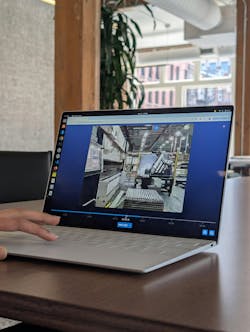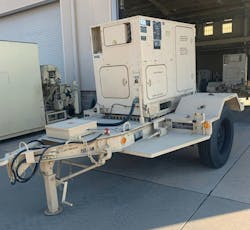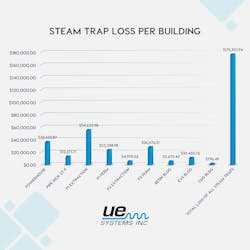Case study roundup highlights proactive and predictive maintenance successes
Key Highlights
- Remote monitoring apps enable quick diagnostics and troubleshooting, minimizing downtime and reducing service costs, as seen with Mid Atlantic Machinery Automation.
- Wireless remote control systems help university facilities manage generator operations efficiently, saving thousands in fuel costs during outages.
- AI-driven condition monitoring detects early signs of equipment failure, allowing predictive maintenance that results in millions in savings at Ingredion.
- Integrated MRO solutions streamline aircraft maintenance processes, increasing efficiency and revenue days for China Airlines amid fleet expansion.
- Motion Amplification technology verifies the effectiveness of vibration mitigation measures, enhancing the safety and reliability of military generators.
- Ultrasound tools improve leak detection and lubrication practices, saving BioKyowa over $261,000 annually through predictive maintenance and extended equipment lifespan.
Maintenance optimization tools and methods are continually expanding and improving, yet there is no better time to leverage their potential than now. Below are six maintenance and reliability case studies demonstrating a resolve to solve existing problems, without fear of missing out on some future innovation. In each case, their decisions and actions met with success.
The tools of choice vary, from purpose-built handheld devices to a strategic downloadable app, an integrated software solution, and online monitoring solutions – some with built-in artificial intelligence (AI) and analytics.
Each company is reaping benefits from their improvement initiative with corresponding efficiencies, cost savings, and reliability gains at minimum, not to mention empowering their teams to operate with better visibility, faster decisions, and less risk.
1. Robotic solution provider uses remote monitoring and troubleshooting on process automation cells
Challenge:
Mid Atlantic Machinery Automation is a robotic automation systems integrator and provider of solutions such as automated press brake tending. Whenever a customer experienced technical issues, on-site troubleshooting and correction was often needed.
A more advanced solution was needed to minimize costly equipment downtime and reduce engineer travel time and expenses.
Solution: Mid Atlantic chose the Olis app, a plug-and-play solution from Olis Robotics that enables remote monitoring, diagnostics, error recovery, and control of robots from the app. Full setup took less than five minutes, including purchasing the Android app online, establishing an ethernet connection to the controller, and configuring the IP addresses. In addition, engineers can set up alerts regarding irregular activity to predict hard stops and prevent them from occurring, and they can share screens for collaborative troubleshooting as needed.
Results: Adding remote monitoring, diagnostics, and control capabilities to Mid Atlantic’s machines helped its service team to better manage the rapidly growing installed base. “Many times, we can fix a problem for our customers in mere minutes at no cost,” says Josh Mayse, vice president and co-founder of Mid Atlantic Machinery Automation. “With the cameras, we see what is going on. We can restart their robots from our (tablet) in just a few clicks. Customers end up wasting less time and consumables because the problem is fixed immediately. Production can start up again much faster to maintain throughput.”
2. University uses remote monitoring and control on backup power generators
Challenge:
George Mason University serves tens of thousands of students as well as faculty and staff across its primary, 677-acre location in Fairfax, VA. An improved approach was needed to keep the campus buildings operational during power outages, reduce utility power downtime when it occurred, and increase efficiencies – especially with some Facilities Management team members living more than 30 miles away.
Furthermore, ensuring the campus’ 35 generators only ran when needed was necessary to control diesel fuel costs.
Solution:
Partnering with Bay Diesel & Generator, the university chose the TrueGuard-PRO wireless remote condition monitoring and control system from OmniMetrix and its cloud-based monitoring software platform, OmniView.
Installing the monitoring units on the generators would provide visibility into accidental starts and stops, and of generators still running after utility power is restored. Utility power losses would generate instant text and email alarms notifications to Facilities Management, prompting them to quickly contact the energy provider, expediting outage response. Additionally, logging in remotely via OmniView would allow them to ensure timely shutdown of affected generators.
Results: The remote monitoring technology delivered ample response time and fuel cost savings. “Typically, per 100 kW of a generator's size, it will use 7.5 gallons of fuel every hour,” says David Bratton, vice president Western Region at Bay Diesel. Preventing 35 generators of this size from accidentally running for one hour at full load, at a modest $2.50 per gallon, saves $656. Preventing them from running unnoticed over a weekend break brings the savings to more than $30,000. At the current average fuel price of $3.64 per gallon, the savings are significantly higher. The campus has 35 monitored generators currently and plans to install more.
3. Ingredients provider uses condition monitoring and AI on critical equipment
Challenge:
The North Kansas City plant of Ingredion, a global food and beverage ingredients company, needed to keep its machines running around the clock but its traditional maintenance tools were not fully up to the job.
Hard-to reach assets slowed inspections, and unnoticed early-stage issues on critical equipment, such as alignment problems or bearing wear, raised the risk of failures, unplanned downtime, and production losses. Easier, faster, and smarter maintenance technologies and processes were needed.
Solution:
Ingredion decided to deploy a real-time condition monitoring solution from Tractian Technologies, including vibration sensors and AI-driven diagnostics, that was already delivering positive results at its South American facilities.
Rolling the solution out to the North Kansas City plant would facilitate inspections there and help predict and prevent breakdowns by providing early warning of issues such as unbalance, looseness, or lubrication anomalies. Armed with alerts, predictive insights, and failure modes, the plant’s maintenance and reliability team would be able to plan and schedule timely corrective actions and avoid full-blown failures.
Results:
Tractian Condition Monitoring caught emerging failures on critical pumps and other Ingredion assets using AI-powered detection. It enabled decisive actions supported by guided recommendations, reduced reliance on manual inspections, and made better use of maintenance resources. At a single facility, it helped Ingredion realize:
- $1.0M in production savings
- $223,000 in maintenance savings
- 168 hours of avoided downtime across critical equipment through early warnings
- Tangible ROI from condition-based alerts and faster issue resolution.
With successful implementations at multiple sites, Ingredion is scaling Tractian solutions across its footprint.
4. Air carrier uses integrated MRO solution for aircraft maintenance
Challenge:
Aviation maintenance, repair, and overhaul (MRO) activities are crucial to the performance and longevity of mission-critical assets. China Airlines (https://www.china-airlines.com/us/en), Taiwan’s largest airline, had legacy mainframe systems that were mostly siloed and operated with various sets of processes, limiting access to critical data insights and MRO efficiency.
Elevating the challenge were aggressive growth plans, an expanding fleet, and a worldwide manpower shortage. The confluence of factors highlighted the need for a digital transformation to minimize risk, maximize reliability, and optimize safety and compliance.
Solution:
A thorough market search led China Airlines to select IFS for its system of record. Connecting the airline’s systems and data into one integrated solution for maintenance program management, configuration and engineering, planning, materials management, and line, heavy, and shop maintenance would enable the airline to find and solve problems before they impact operations.
Improved operational visibility, MRO process optimization, access to critical data from the field, and a just-in-time supply model would drive labor and cost efficiencies and ensure safer, more reliable passenger and cargo service.
Results:
China Airlines gained numerous benefits from the integrated solution, which continues to drive improvements in MRO quality and efficiency:
- 65 percent reduction of multi crew job card waiting time in heavy maintenance
- 10 percent increase in line management process efficiencies
- 10 percent increase in heavy maintenance manpower efficiencies
- 3 percent increase in “A check” (lighter inspection) delivery efficiencies
- Average addition of 30 revenue days per year through a reduction in scheduled aircraft maintenance
- Average addition of 25 revenue days per year through a reduction in unscheduled aircraft maintenance
5. Technology services provider uses Motion Amplification on power generators
Challenge:
Tactical generators that power Army weapon systems in all environmental and threat conditions must meet exact standards for power quality. During initial testing of 15 kW/400 Hz generators at a U.S. Army Depot in Pennsylvania, incidences of stator weld fractures leading to catastrophic generator failure occurred.
When structural resonance was identified as a cause of the fractures, the Integrated Fires Mission Command (IFMC) proactively developed a stiffening and damping kit to mitigate the issue. However, IFMC needed a reliable means to verify the repeatability of the kit installation, validate its effectiveness in real-world conditions, and guarantee maximum generator efficiency.
Solution: A service technician was dispatched from Cintel Inc., a provider of technical services supporting multiple Defense programs, to detect and analyze latent defects in the generators using the Iris M system and Motion Amplification (MA) software from RDI Technologies. This technology allows users to see and measure motion that is invisible to the human eye, enabling the technician to establish a standard operating baseline for each generator, analyze vibration data from the production assets, compare modified and unmodified generators, and develop a repeatable testing procedure for all production assets.
Results: With the MA-established baseline, Cintel was able to detect, quantify, and qualify a rotor-hub separation problem causing ground fault and catastrophic failure – a finding that was instrumental in improving new inspection procedures and safety components and a production process. Cintel also detected, quantified, and qualified an early-stage mechanical looseness problem causing excessive vibration in some generators, leading to new torque procedures across the fleet. Ultimately, the MA data and analysis not only confirmed the kit’s effectiveness in reducing resonance, but it also supports ongoing efforts to ensure the generators provide stable electrical power to crucial weapon systems.
6. Biochemical producer uses ultrasound technology on lubrication, air leaks, and steam traps
Challenge:
Biochemical manufacturer BioKyowa produces high-quality amino acids used in products such as nutritional food supplements, cosmetics, and precursors for pharmaceuticals. Its technicians sought to be more efficient at performing air leak and steam trap surveys and lubrication routes across the Missouri facility.
Additionally, pinpointing the precise location of issues found during vibration routes, such as ultra-high frequency bearing noise in a recirculating fan, had been challenging.
Solution:
Their search for new tools led to ultrasound technology, including the Ultraprobe 15,000, Ultraprobe 401 Grease Caddy, and complementary software from UE Systems.
The Ultraprobe 15,000 would allow the technicians to analyze and diagnose everything from bearings and electrical systems to steam traps and leaks, enabling timely predictive actions before failure. The Grease Caddy would improve lubrication precision with real-time evaluation of friction in bearings.
Results: With condition-based lubrication, BioKyowa’s technicians observed significantly extended lifespans for their bearings and reduced the frequency of grease application. With ultrasound monitoring and analysis, they discovered an annual loss of $175,901 from failed steam traps as well as an $86,000 loss from air leaks, and the resultant predictive maintenance saved them more than $261,000 annually. In just a few months, the savings covered the entire cost of the devices. The manufacturer remains committed to using advanced technologies such as ultrasound as part of their comprehensive reliability program.
Conclusion: The case for case studies
Published case studies that bring operational improvements to light are a positive indicator of a culture of continuous improvement. Industrial organizations especially benefit from stories celebrating gains in safety, efficiency, uptime, and performance and reductions in waste and costs. They project values appreciated not only in the corporate world but also by your employees, prospective employees, and surrounding communities. What’s your story?
About the Author

Sheila Kennedy
CMRP
Sheila Kennedy, CMRP, is a professional freelance writer specializing in industrial and technical topics. She established Additive Communications in 2003 to serve software, technology, and service providers in industries such as manufacturing and utilities, and became a contributing editor and Technology Toolbox columnist for Plant Services in 2004. Prior to Additive Communications, she had 11 years of experience implementing industrial information systems. Kennedy earned her B.S. at Purdue University and her MBA at the University of Phoenix. She can be reached at [email protected] or www.linkedin.com/in/kennedysheila.



